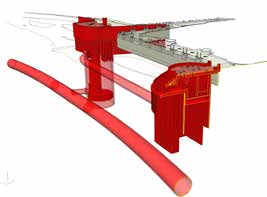It is a fixed-cost project; the 50 companies in the construction partnership want to stay on top of the huge amount of data the 23-year project will accumulate.
Thames Water, the private utility company responsible for water supply and wastewater treatment across London and the Thames Valley, has launched a massive project to upgrade London’s Victorian-era sewer system to meet modern-day needs and improve water quality in the River Thames for future generations. The estimated £4.1 billion ($6.2 billion) Thames Tideway Tunnel, which will run 15 miles from west to east London, will broadly follow the path of the River Thames, and will be the final and most challenging part of the proposed sewer system improvements, which will tackle the problem of sewer outflows into the river. The tunnel project will be London’s deepest when completed in 2026.

Thames Water appointed CH2M HILL as the program manager for the Thames Tideway Tunnel project, with Halcrow and Tunneling Limited as key subcontractors. As a long-time Bentley user, CH2M HILL selected Bentley ProjectWise to provide collaboration, work sharing, and engineering content management for Thames Water’s Thames Tideway Tunnel project.
Currently there are more than 20 principal partners involved in the project and 50 other companies engaged in the pre-planning phase. The project team needed a scalable solution to facilitate collaboration with multiple subcontractors and allow them to accurately predict costs for this fixed-price project. The partnership will use ProjectWise to manage design processes, project data, governance, standards, and subcontractors within a single data environment.
With the need to deliver value for money and meet water quality standards, the team is using British Standard BS 1192 inside ProjectWise to gain maximum efficiency. BS 1192 provides a method for managing production, distribution and quality of construction information, using a disciplined process for collaboration to increase productivity and reduce project costs.
Simon Williams-Gunn, engineering systems lead, Thames Tideway Tunnel project, said, “We are going to be expanding into a huge team to deliver the project, and we wanted to put into place tools that enabled us to both accommodate the requirements at an early stage of the project and also scale into the full delivery of the project as it grows.”
The Thames Tideway Tunnel team is taking advantage of the new ProjectWise Business Process Template that incorporates the BS 1192 processes and naming standards, with appropriate folder structures and workflow conventions. ProjectWise also provides the team with automated support of numerous data management activities including searching, creating, registering, checking, and issuing documents, as well as the tools for managing CAD standards to ensure that the growing team can create consistent work.
Williams-Gunn says the project team has been able to more accurately cost the project and minimize the risk of needing additional resources for information management. “We needed to predict what the costs would be due to it being a fixed-cost project. If we had put in the resources required to manually manage this much information, the cost would have probably been 10 times that of our new system, and that’s a conservative figure.”
3D modeling of an evolving project
The London sewer system uses a single pipe to carry both sewage and stormwater runoff. It was designed to overflow into the tidal River Thames via combined sewer overflows (CSOs) only during extreme rainfall, when the sewers reach capacity, to prevent homes and streets from flooding. However, modern-day pressures, including population growth and the increased intensity of precipitation in the U.K., have resulted in increased discharges into the tidal River Thames–with discharges occurring, on average, once per week.

To capture this overflow before it reaches the river, there will be shafts six meters across and 60 meters deep at 22 CSO sites along the path of the tunnel that drop the flow down to the main tunnel. “There is a huge amount of engineering that goes into actually capturing the CSO. So we’re building a building underground, if you like, using [Bentley] Structural Modeler to create 3D models,” Williams-Gunn explained. In addition, Structural Modeler and Bentley AECOsim Building Designer are being used to create 3D models of other elements and structures at the CSO sites, including the shafts, head houses, stacks, and other buildings and landscaping.
These 3D models are shared with other software tools for fluid dynamic calculations as well as GIS software for studying the environmental impact of the stacks and the resulting odor. Bentley STAAD is used for structural analysis of reinforcement issues, such as where CSOs enter the river near bridges. The 3D models are also used to produce the 2D drawings necessary for engineering, planning, and environmental needs.
The tunnel will be London’s deepest ever—75 meters (246 feet) down at its lowest point. With the myriad underground structures beneath the city, the project team must avoid the many other tunnels and conduits used for rail, road, electricity, gas, and communications infrastructure. Moreover, it must prevent ground settlement from damaging the surrounding buildings. Settlement analysis will be conducted wherever the tunnel passes beneath or close to buildings and other structures, and mitigation efforts will be implemented as required. The team is using Bentley InRoads to manage horizontal, vertical, and 3D alignments of both the main tunnel and various connection tunnels.
Our take
In every market for professional software, there seems to be a never-ending debate between the use of point solutions—individual products for specific tasks—and more encompassing solutions. A $6 billion fixed-cost project like the Thames Tideway Tunnel doesn’t have the time or money to allow interoperability problems and individual approaches to data management drag down the project. Only Bentley has the unified platform and aligned software tools to take on such a massive endeavor.





